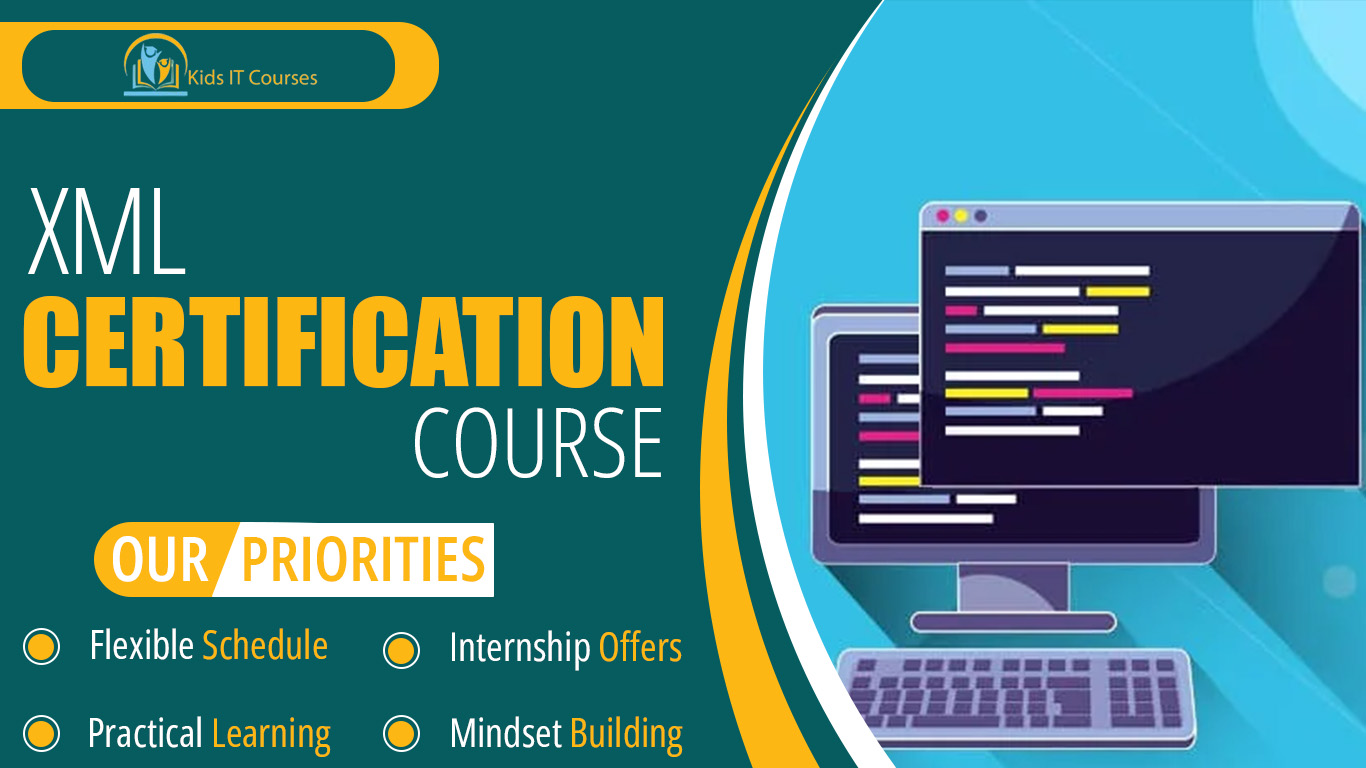
XML Course for Kids
Definition
• Kids learn how to keep data in a clean and neat way. XML helps sort things like names, dates, and scores.
• XML stands for eXtensible Markup Language. It’s a way to store and share data using text.
• Kids use special words called tags like <name> or <age>. These tags help label the data clearly.
• XML is used to send data between apps, games, and websites. It’s like giving clear instructions that computers understand.
• Kids learn to follow rules and structure while writing XML. This helps with neat thinking and attention to detail.
•XML is a good start before learning bigger coding languages. It helps kids get ready for smart tech learning.
Importance
• Kids learn to keep data neat using tags. XML is like putting things in labeled boxes.
• XML stands for eXtensible Markup Language. It helps computers understand and share information.
• XML lets apps and websites share data smoothly. It’s like a universal language for computers.
• Kids use tags like <name> or <score> to hold info. It’s simple and easy to understand.
• They learn how to plan and organize step by step. This improves clear thinking and tech understanding.
• XML is used in games, e-books, and websites. Kids get to learn tools used by real developers.
Advantages for Freelancing
• Kids learn how to arrange data using tags. It’s like putting facts in clearly labeled boxes!
• They learn to think step-by-step while writing code. It helps improve focus and smart planning.
• XML is used to keep data for websites and apps. Kids see how things like scores, names, and lists are saved.
• XML looks like plain English with simple symbols. Even beginners can learn it quickly.
• Games, websites, and mobile apps use XML to work. Kids learn tools used by real developers.
• They can use XML to create mini data files or digital cards. It makes tech learning fun and useful!
Session 1 : What is XML?
- Introduction to XML as a markup language for storing and transporting data
- Real-life example: Using XML for data exchange between different applications (e.g., mobile apps and servers)
- The basic structure of XML: Elements, attributes, and tags
- Installing and setting up XML editor tools (e.g., Notepad++, Visual Studio Code)
- Activity: Write your first simple XML document
Session 2 : XML Syntax and Structure
- Understanding the rules for writing valid XML (case sensitivity, nesting, and closing tags)
- Real-life example: Structuring a list of books with titles and authors
- Common XML elements and attributes
- Activity: Create an XML document with a list of your favorite books or movies
Session 3 : XML Namespaces and Schema
- Introduction to XML namespaces and their purpose in avoiding naming conflicts
- Validating XML documents with XML Schema (XSD)
- Real-life example: Defining product information with specific data types (like prices, dates)
- Activity: Create an XML Schema and validate an XML document
Session 4 : XPath – Navigating XML Documents
- Introduction to XPath for navigating XML documents
- Real-life example: Searching for a specific element (like a product name) in an XML file
- Using XPath to filter and extract data from XML
- Activity: Write XPath queries to extract information from an XML document
Session 5 : XSLT – Transforming XML Data
- Introduction to XSLT (Extensible Stylesheet Language Transformations)
- Using XSLT to transform XML data into HTML, plain text, or other formats
- Real-life example: Displaying product data in a readable format on a webpage
- Activity: Transform an XML document into an HTML page using XSLT
Session 6 : Working with XML in Programming Languages
- Using XML in programming languages (Java, Python, PHP)
- Real-life example: Reading and writing XML files in an application
- Introduction to DOM (Document Object Model) and SAX (Simple API for XML) for XML parsing
- Activity: Write a Python script to parse an XML file and extract data
Session 7 : XML and Web Services (SOAP and REST)
- Introduction to XML in web services (SOAP, REST APIs)
- Real-life example: Sending and receiving data in XML format through web services
- Using XML for data exchange in RESTful APIs
- Activity: Create a simple SOAP or RESTful web service using XML for communication
Session 8 : Best Practices for Working with XML
- XML naming conventions and formatting best practices
- Ensuring XML data consistency and integrity
- Real-life example: Organizing large XML documents for better readability and management
- Activity: Clean up and optimize an XML file with proper formatting and organization
Bonus Materials
- XML syntax cheatsheet and XPath guide
- Mini projects: Create an XML-based configuration file, XML to JSON conversion tool
- Free resources for learning XML and XSLT
- Certificate of Completion for XML Mastery
